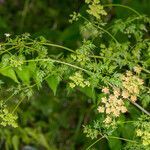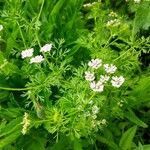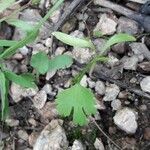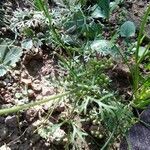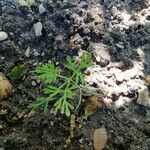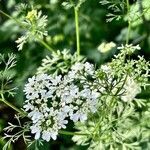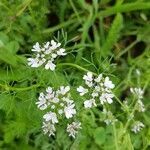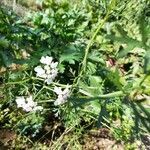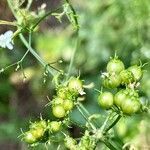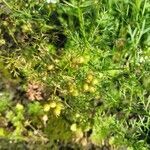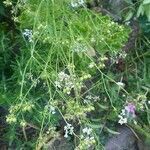Annual, entirely glabrous. Stems to 75 cm, terete, striate. Lower leaves palmatilobate to-partite, middle leaves pinnate, segments gradually narrower, obtuse, upper leaves pinnate to bipinnate, segments ½ mm broad. Compound umbels terminal or seemingly lateral, peduncles 2-10 cm; rays 3-5, 1-2½ cm; pedicels 3-5 mm; involucres 0-1, to 5 mm; involucels 3-5, to 5 by ½ mm, linear. Calyx teeth nearly 1 mm, triangular-lanceolate to oblong-lanceolate, somewhat radiating. Petals white, radiating, outer ones 3-4 mm, all deeply bipartite with inflexed tips. Mericarps 4 by 2 mm, inside hollow, forming a nearly globose fruit; primary ribs undulated lines, secondary ribs subprominent, filiformous.
Plants to 60 cm high. Basal and lower leaves pinnate to 2-pinnatisect; petiole to 13 cm, shortly sheathing at base; blade ovate, to 14 × 8 cm; pinnae broadly ovate or flabelliform, 1–2 × 1–1.5 cm, variously toothed or incised; ultimate segments broad. Mid and upper cauline leaves ternate-2–3-pinnatisect, reducing up the stem; ultimate segments linear to filiform, 2–15 × 0.5–1.5 mm, obtuse, entire. Peduncles 2–10 cm; rays 2–8, 1–2.5 cm; bracteoles 2–5, linear, entire; umbellules 3–9-flowered. Pedicels 2–5 mm. Calyx teeth ovate-deltoid or ovate-lanceolate, unequal. Fruit 1.5–5 mm wide. Fl. and fr. Apr–Nov.
An annual herb up to 70 cm high. It spreads to 50 cm across. It has a fleshy taproot. The stem is erect and finely grooved. The leaves are compound, and divided along their length. The lower leaves have lobes, while the upper leaves are finely divided. The leaves are bright green, and glossy. Flowers are pink to white. They occur in flat arrangements, with stalks coming from the same point. The plant has an unpleasant smell until the fruit ripens. The fruit are pale brown. The fruit have lines along them. Some lines are wavy and some are straight.
Annual herb, up to 1 m high, strongly aromatic. Stem erect, with slender taproot. Leaves pinnate or bipinnate, dimorphic; lower ones with broad, cuneate segments, upper ones with slender, linear segments. Flowers in terminal and lateral umbels; involucre inconspicuous or absent. Calyx with conspicuous, triangular teeth, outer ones larger. Petals white to pink, outer ones of outer flowers much enlarged. Flowering time Sept.-Feb. Fruit globose, glabrous, with inconspicuous blunt ribs; vittae absent; carpophore bipartite. Seeds concave on inner face.
Erect annual. Stems solid, finely grooved, striate, up to 40 cm high. Basal lvs 1-pinnate, petiolate; leaflets pinnatifid or irregularly lobed, serrate, sessile, c. 10-30 mm long. Stem lvs dissimilar to basal, 2-4-pinnate, shortly petiolate; segments linear. Umbels 1-3 cm diam.; rays 3-6; bracts 0-1, linear; bracteoles usually 3-4, linear. Fls few to numerous, white or pink, the outer irregular, up to 6 mm diam. Fr. globose, reddish brown, c. 4-5 mm long; mericarps not separating at maturity.
Annual herb. Flowering stems up to 0.7 m high; erect, glabrous. Leaves radical and cauline, compound; basal ones 1-or 2-pinnate, segments ovate in overall outline, apices acute, base cuneate; upper leaves finely divided into linear segments. Flowers: involucral bracts 0; outer petals of outer flowers in each umbel much enlarged, 5-6 mm long; white to pinkish; Oct. Fruit suborbicular, ribs filiform, zigzag markings between them.
Erect, branched above, 3–7 dm; lowest lvs simple or variously divided into obovate incised segments; upper lvs pinnately dissected into linear segments; outer enlarged pet to 4 mm; fr 3–5 mm wide; sep persistent, those of the outer row of frs 1 mm or more; 2n=22. Native of the Mediterranean region, established as a weed over much of the U.S., especially southward. June, July.
Annual herb, up to 0.7 m high. Lower leaves 1-or 2-pinnate, segments ovate in overall outline; with cuneate base. Upper leaves finely divided into linear segments. Mericarps suborbicular, with obtuse filiform ribs, with zigzag markings between them. Outer petals of outer flowers in each umbel much enlarged. Flowers white to pinkish white.
Upper leaves finely divided into a linear to narrowly linear segments 2–15 × 0·5–1·0 mm., obviously markedly different from the basal leaves but sometimes connected by intermediate types on the lower-middle part of the stem.
Lower leaves 1–2-pinnate, segments 10–20 × 5–10 mm., ovate in overall outline, with a regularly cuneate base, somewhat unevenly divided into pinnate lobes.
Fruit 2–3 mm. in diameter, suborbicular, slightly longer than broad. Mericarps with obtuse filiform ribs, with zigzag markings between them.
Umbels terminal and lateral; bracts O; rays 3–7 (10), 1–2 cm. long; partial umbels with 2–7 flowers; bracteoles few, linear-lanceolate.
An erect annual, almost glabrous herb up to 70 cm., with a slender taproot and a strong unpleasant smell.
Stems often simple, but in large plants may be profusely branched, with fine regular grooves.
Styles long and slender, often eroded from the conical stylopodium before maturity.
Vittae absent; seed concave on the inner face: carpophore divided to the base.
Petals white to pinkish-white; the outer ones distinctly radiate.
Calyx teeth narrowly triangular and quite conspicuous.
